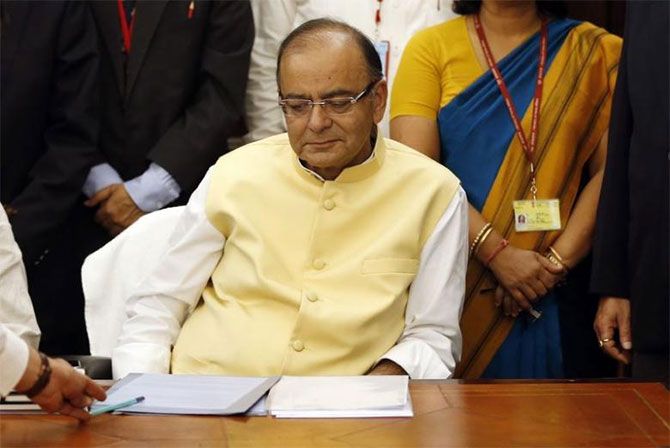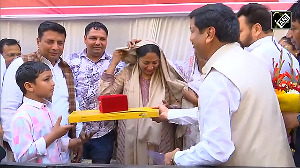Against a turbulent and uncertain background, Budget 2017-18 hewed a steady, forward-looking course, says Shankar Acharya, former chief economic adviser to the government.

Many have damned the Union Budget 2017-18 with faint praise: 'Workmanlike', 'conservative', 'middle of the road', 'does no harm', 'please-all' and so on. This is unfair.
Had this been a normal year, then these descriptions may have been closer to the mark. But the times are far from normal.
The circumstances for Budget-making were extraordinarily difficult, perhaps the most challenging since the summer of 1991.
For Finance Minister Arun Jaitley and his team to have delivered a decent Budget in these trying times deserves high praise. It would have been so easy to have been blown off course by some potent mix of populism and adventurism.
Consider some of the challenges. The Indian economy and its finances were still reeling from the short-run, adverse consequences of the massive and unprecedented demonetisation policy announced in November.
The extent of the impact could not be captured by the official advance estimates of the Central Statistics Office, published a month earlier than normal to match advancing the Budget date; so the Budget-makers were handicapped by the absence of sound estimates of economic growth.
With the switch-over to the national goods and services tax (GST) expected in July-September, projections of indirect tax revenue were subject to unprecedented uncertainty.
Integration of the Railway Budget into the General Budget and abolition of the Plan/non-Plan distinction posed special challenges.
The competing demands on the time, attention and resources of the Budget team posed by the contemporaneous issues of demonetisation management and the final stages of GST negotiation/preparation were running high.
The challenges posed to the Election Commission and the Supreme Court regarding the Budget date could not have helped.
Nor could the new stresses in the global economy and polity from the historic events of last year.
Against this turbulent and uncertain background, the Budget 2017-18 hewed a steady, forward-looking course.
There are many good things about the Budget. I will only highlight a few favourites:
- With a projected fiscal deficit of 3.2 per cent of gross domestic product (GDP), the Budget is fiscally prudent. For those calling for a stronger fiscal stimulus to a slowing economy, I would point to the likely expansion of state fiscal deficits as they imitate the central government’s pay hikes of the previous year and bear their share of uncertainty from demonetisation and the transition to GST. It is very likely that the combined deficit will be close to 6.5 per cent of GDP. Together with the ongoing 'remonetisation”' that should be expansionary enough.
- While total expenditure growth is restrained to 6.6 per cent, there is good support for the priorities of infrastructure, agriculture and rural development, and capital expenditure.
- The proposal for electoral bonds is a promising initiative for helping clean up our cash- and black money-intensive system for political funding.
- The Budget eschews populist, new expenditure schemes, including the recent fad of an “universal basic income”, which would be a remarkably bad idea for India at her current stage of development. As others have pointed out, it would likely end up as a fiscally ruinous add-on to the existing scheme of subsidies, rather than a replacement.
- It also resists the siren song for a single (or double), reduced rate(s) of income tax to promote compliance. Although the top rate of income tax has been halved since 1985, there is little evidence of a dramatic improvement in compliance since then. Furthermore, despite widespread rumours, the basic tax regime for capital markets has not been disturbed. Nor has the previous government’s four-year dalliance (2005-2009) with the ill-considered bank cash withdrawal tax been revived.
- The decision to extend to the leather and footwear industries an employment-promoting scheme, similar to the one launched some months ago for the textile sector, is most welcome. Why not extend this framework to other labour-intensive, manufacturing sectors?
- The Budget process reform to bring forward the date of presentation by a month, dispense with the vote-on-account and complete parliamentary approval of the Budget by March 31 is commendable. It will ensure transmittal of spending authority to ministries concerned, states and agencies by early April and thus avoid the constriction of the pre-monsoon “working season” period for government public works because of the Budget process delays.
No Budget is without flaws and disappointments. This one is no exception.
First, there is no road map to deal with the very large problem of highly stressed public sector bank balance sheets, with stressed assets accounting for nearly 20 per cent of their loans.
As a result, both net bank lending and private investment are stagnating, symptoms of what the Economic Survey calls the 'festering twin balance sheet problem'.
Nor is this problem going to go away. Solutions have to be found, and sooner the better.
Second, despite the government’s demonstrated success in moving ahead with direct cash transfer programmes in many areas, including securing substantial saving on cooking gas subsidies, the Budget does not outline similar initiatives for the major subsidies of food and fertilisers, which together account for about 10 per cent of total government expenditure.
Third, the Finance Bill strengthens the existing provisions for search and seizure in several ways, according greater effective authority (and with less accountability) to income tax assessing officers.
This is unfortunate in the after-demonetisation context, where the target domain for investigation of bank accounts and deposits has increased greatly, and the need for ensuring accountability against arbitrary and inappropriate harassment of assessees has risen commensurately.
Fourth, the replacement of the entry-level 10 per cent income tax rate with a reduced five per cent rate has left the income tax rate structure (5-20-30) in an odd situation, where the marginal rate of tax quadruples at the Rs 5-lakh taxable annual income level.
Fifth, the allocation for defence expenditure is too low.
On balance, the finance minister and his team deserve congratulations for crafting a good Budget under very difficult circumstances.
Image: Finance Minister Arun jaitley.












 © 2025
© 2025